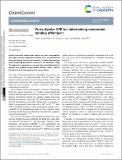Files in this item
Pulse dipolar EPR for determining nanomolar binding affinities
Item metadata
| dc.contributor.author | Ackermann, Katrin | |
| dc.contributor.author | Wort, Joshua | |
| dc.contributor.author | Bode, Bela E. | |
| dc.date.accessioned | 2022-07-21T13:30:11Z | |
| dc.date.available | 2022-07-21T13:30:11Z | |
| dc.date.issued | 2022-08-14 | |
| dc.identifier | 280450644 | |
| dc.identifier | 8ff493c6-25e6-4a74-8f7e-10cdc0d1e1a5 | |
| dc.identifier | 85134594065 | |
| dc.identifier | 000825556600001 | |
| dc.identifier.citation | Ackermann , K , Wort , J & Bode , B E 2022 , ' Pulse dipolar EPR for determining nanomolar binding affinities ' , Chemical Communications , vol. 58 , no. 63 , pp. 8790-8793 . https://doi.org/10.1039/D2CC02360A | en |
| dc.identifier.issn | 1359-7345 | |
| dc.identifier.other | ORCID: /0000-0002-3384-271X/work/115941493 | |
| dc.identifier.uri | https://hdl.handle.net/10023/25684 | |
| dc.description | This research was funded, in whole or in part, by the Wellcome Trust (204821/Z/16/Z). BEB and KA acknowledge support by the Leverhulme Trust (RPG-2018–397). JLW acknowledges support by the BBSRC DTP Eastbio. BEB acknowledges equipment funding by BBSRC (BB/R013780/1 and BB/T017740/1). | en |
| dc.description.abstract | Protein interaction studies often require very low concentrations and highly sensitive biophysical methods. Here, we demonstrate that pulse dipolar electron paramagnetic resonance spectroscopy allows measuring dissociation constants in the nanomolar range. This approach is appealing for concentration-limited biomolecular systems and medium-to-high-affinity binding studies, demonstrated here at 50 nanomolar protein concentration. | |
| dc.format.extent | 4 | |
| dc.format.extent | 853265 | |
| dc.language.iso | eng | |
| dc.relation.ispartof | Chemical Communications | en |
| dc.subject | QD Chemistry | en |
| dc.subject | DAS | en |
| dc.subject.lcc | QD | en |
| dc.title | Pulse dipolar EPR for determining nanomolar binding affinities | en |
| dc.type | Journal article | en |
| dc.contributor.sponsor | The Wellcome Trust | en |
| dc.contributor.sponsor | The Wellcome Trust | en |
| dc.contributor.sponsor | The Leverhulme Trust | en |
| dc.contributor.sponsor | BBSRC | en |
| dc.contributor.sponsor | BBSRC | en |
| dc.contributor.institution | University of St Andrews. School of Chemistry | en |
| dc.contributor.institution | University of St Andrews. Institute of Behavioural and Neural Sciences | en |
| dc.contributor.institution | University of St Andrews. EaSTCHEM | en |
| dc.contributor.institution | University of St Andrews. Biomedical Sciences Research Complex | en |
| dc.contributor.institution | University of St Andrews. Centre of Magnetic Resonance | en |
| dc.identifier.doi | https://doi.org/10.1039/D2CC02360A | |
| dc.description.status | Peer reviewed | en |
| dc.identifier.grantnumber | 204821/Z/16/Z | en |
| dc.identifier.grantnumber | en | |
| dc.identifier.grantnumber | RPG-2018-397 | en |
| dc.identifier.grantnumber | BB/R013780/1 | en |
| dc.identifier.grantnumber | BB/T017740/1 | en |
This item appears in the following Collection(s)
Items in the St Andrews Research Repository are protected by copyright, with all rights reserved, unless otherwise indicated.

